| |||||
| |
|||||
| |||||
- Genome Institute Completes Draft of 3 Chromosomes
- Pinning Down Gene Expression
- Open House Parking Guide
- Washington Report
- Lab Awarded Golf Tournament Trophy
- Guggenheim Fellowships
- Tritium at Center of School Board Controversy
- Berkeley Lab Currents
- Berkeley Lab Part of "Virtual Lab" for Fusion R&D
- Rep. Calvert Visits Genome Institute
- Lab Program Gives New Meaning to Student Internships
- DOE Diversity Program Easily Available to All
- Bulletin Board
- Calendar of Events
- EH&S Classes - May 2000
- New Lead Hazard Course
- Currents Online
- Flea Market
- Flea Market Policy
Heart of the Matter
Behavior
of mouse genes may lead to understanding
possible treatment of heart disease in humans
By Paul Preuss
In a heart under severe stress, some cells die and others overcompensate. Instead of dividing, they grow larger in a process known as cardiac hypertrophy, which increases stress and in turn may cause surviving cells to grow larger still -- a positive feedback loop that can end in catastrophic failure.
Genes trigger these changes in response to environmental factors such as a diminishing oxygen supply or an increase in blood pressure. Finding which genes are responsible is the first step to a fundamental understanding of the mechanisms of cardiac hypertrophy.
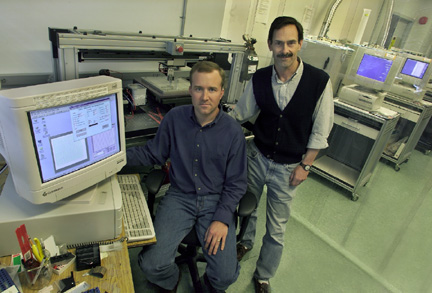 |
To date 4,700 out of some 100,000 genes of the mouse genome have been cloned and identified -- that is, their sequences and some of their protein products are known -- and in the near future, researchers expect to identify another 8,000. The biological role most of these play is far from certain.
Mice are good physiological models for humans, but it takes more than rich food and too much television to give them heart disease. Instead, cardiac hypertrophy is induced by treating young mice with drugs over a period of one to 13 days. Control mice of the same age are given saline solution.
"In test mice we are using drugs such as angiotensin II and isoproterenol, which are proven to induce cardiac hypertrophy," says Friddle. "A spot on the microarray that lights up red in a test with one drug but not in another means the gene is responding to the metabolism of the drug -- not to the disease. So we repeat the tests with different drugs. Spots that light up repeatedly signal genes associated with the hypertrophic mechanism itself."
Because the drugs themselves can induce gene expression, drugs are not the best physical model for hypertrophy. It is also possible to induce hypertrophy by constricting the heart's major artery, a technique called aortic banding that has been used in rats but only recently applied to mice. By comparing results from drug tests to results from aortic banding, candidate heart-disease genes can be identified with near certainty.
"We have identified a number of genes that show statistically significant changes in expression in response to heart disease induced by drugs," Friddle says. "We've also found several genes that are involved only in regression -- that is, recovery from hypertrophy -- an area that has not been well researched before now."
At the heart of this research program is gleaming robotic-microarray machinery behind a protective curtain of clear plastic, which turns out precision copies of glass slides holding cDNA from thousands of genes; the Berkeley Lab study is one of the first to study tissues from whole-animal models of the disease in this way.
While much remains to be done, the study's first results will soon appear in the Proceedings of the National Academy of Sciences. The promise is for a much more detailed understanding of the interaction of genes and environment in cardiac hypertrophy, understanding that may help prevent heart disease and perhaps lead to ways to stop heart attacks in progress.
Mouse Gets Even Better as Human Genome Model
By Lynn Yarris
 |
In a paper published in the April 7 issue of the journal Science, the researchers report that comparative analysis techniques used to identify DNA sequences coding for genes in mice and humans can also be used to identify sequences that regulate the "expression" or activation of genes.
"You could call this finding jewels in junk DNA," says Edward Rubin, a geneticist with Berkeley Lab's Life Sciences Division and co-leader of the study along with Kelly Frazer. "By comparing human and mouse sequences we can identify those segments of the genome that contain information which instructs surrounding genes on when and where they are to be active. Identifying these sorts of regulatory sequences using classical biological approaches is labor intensive and difficult."
Evolutionary conservation of non-coding DNA sequences that play an important role in regulating gene expression is the key to the success of this study, just as it has been a key to identifying DNA sequences that code for genes across different species.
"If evolution conserved a sequence over the 70 to 90 million years since mice and humans diverged, it likely has a function," says Frazer. "Whether its function is to determine the structure of a protein coded for by a gene or to regulate gene expression, we should be able to identify these sequences through mouse to human sequence comparisons."
In addition to Rubin and Frazer, other authors of the Science paper were Gabriela Loots and Cathy Blankespoor of Berkeley Lab, Richard Locksley and Zhi-En Wang of UCSF and the Howard Hughes Medical Institute, and Webb Miller at Penn State University.
As the various genome projects, including that of the human and the mouse, speed toward completion, scientists are already moving to the next phase, which is identifying those sequences of DNA base-pairs that have critical functions. Using computers to compare sequences that code for a known gene in mice with sequences in human DNA has proven to be an effective means of identifying the human gene.
Rubin and his research group have used this approach to help them identify genes linked to Down syndrome, atherosclerosis, and, most recently, asthma.
However, approximately 95 percent of the sequences in the human genome do not code for genes. Once labeled as"junk" DNA, it has long been known that some of these sequences have important duties, including the regulation of gene expression. It is also believed that these non-coding sequences have been conserved between related species such as mice and humans, just like sequences that code for genes.
To search for conserved non-coding sequences (CNSs), Rubin, Frazer and their colleagues examined a stretch of DNA about a million base-pairs in length from mice and humans that contained the same 23 genes in both species, including three interleukin genes (IL-4, IL-13, and IL-5). Previous studies indicated that these interleukin genes are similarly regulated and that their regulatory sequences may be conserved in mice and humans.
The Berkeley researchers looked for CNSs that were at least 70 percent identical in both species over at least 100 base pairs. Of the 90 CNSs they identified that met this criteria, the researchers took 15 and did a cross-species sequence analysis which also included DNA from a cow, a dog, a pig, a rabbit, a rat, a chicken, and a fish. Most of these elements were also found to be present in the other mammals, indicating that they most likely have been conserved because they perform an important biological function.
The cross-species sequence analysis was followed by an in-depth functional analysis of the largest of the 15 sequences, CNS-1, which encompasses 401 base-pairs and is located between IL-4 and IL-13. Biological properties of CNS-1 were characterized through multiple lines of transgenic mice and revealed CNS-1 to be a "coordinate regulator" of the three interleukin genes, activating them by modulating the structure of chromatin. There is, the authors state, no standard in-vitro assay that could have been used to make this determination.
"What is unique about our study is that we were led to the interleukin regulatory element CNS-1 entirely by computational analysis of mouse and human sequences," says Rubin. "Since we are soon to have the entire genomes of mice and humans sequenced, our study demonstrates one successful strategy of interpreting the sequence information coming from the genome program into meaningful biology."
Genome Institute Completes Draft of 3 Chromosomes
By Lynn Yarris
DOE's Joint Genome Institute (JGI), of which Berkeley Lab is one of three institutional collaborators, has announced the complete sequencing of a "working draft" of human chromosomes 5, 16 and 19. Consisting of more than 300 million base pairs, or about 10 percent of the entire human genome, these three chromosomes are thought to contain as many as 15,000 genes, including those whose defects have been linked to prostate and colorectal cancers, atherosclerosis, certain forms of kidney disease, leukemia, hypertension, and diabetes. Sequencing information from this working draft is "available freely and without restrictions" through GenBank, DOE's public database.
"Three chapters in the reference book of human life are nearly complete," said Energy Secretary Bill Richardson in a speech on April 13 at the 25th Annual American Association for the Advancement of Science (AAAS) Colloquium on Science and Technology Policy in Washington, D.C. "Scientists can already mine this treasure trove of information for the advances it may bring in our basic understanding of life, as well as applications such as diagnosing, treating and eventually preventing disease."
The JGI, located in Walnut Creek, is one of the largest publicly funded human genome sequencing centers in the world. Established by the DOE in 1997, it is operated as a consortium consisting of Berkeley Lab and the national laboratories at Livermore (LLNL) and Los Alamos (LANL).Researchers at Oak Ridge National Laboratory are analyzing JGI's sequences to identify the genes contained within.
At a press conference following Richardson's announcement, JGI director Elbert Branscomb of LLNL said of the consortium's ahead-of-schedule achievement, "All involved in this great international labor of discovery are tremendously excited, delighted, and even a little surprised by how swiftly it is now racing towards its wonderful, revolutionizing goals. Of course, we are extremely pleased to have reached our draft milestone as part of that effort."
In JGI's working draft, sequencing gaps were left in those regions of the three chromosomes believed to contain relatively few genes. Over the next several years, JGI researchers will sequence all three chromosomes in their entirety, improving both the completeness and the accuracy of the genetic information. Chromosome 5 contains an estimated 194 million bases, chromosome 16 is about half that size, and chromosome 19 a little less than a third. In all, the human genome consists of approximately 3 billion base pairs containing anywhere from 80,000 to more than 100,000 genes.
It is the ultimate goal of the Human Genome Project to map and sequence the full complement of genetic material in a human cell. The project was started in 1986 by the DOE out of its Congressional mandate to "study the genetic and health effects of radiation and chemical by-products of energy production." Today the Human Genome Project is a joint international effort between DOE, the National Institutes of Health, and the Wellcome Trust in England.
A working draft of the entire human genome should be finished in June and the final sequence should be available by the year 2003.
Pinning Down Gene Expression
In the microarray technique, robotic pins place microscopic dots of complementary DNA (cDNA) from different genes on glass slides, each holding up to 10,000 spots in a 100 x 100 array. The single-stranded length of cDNA in each spot is capable of binding to the messenger RNA (mRNA) that codes for that gene's product.
To find out which genes are expressed in cardiac hypertrophy, mRNA representing all the gene products present in tissue from diseased mouse hearts is labeled with red-fluorescing dye, then mixed with mRNA from a normal mouse heart, which is labeled with green-fluorescing dye. The mixed mRNAs are then allowed to react, or "hybridize," with all the cDNAs on a slide.
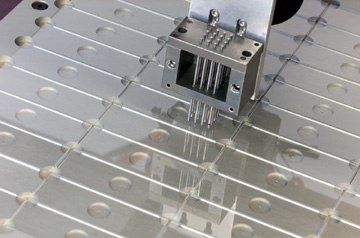 |
Images of the slides are compared by a computer program that measures the brightness of each spot and its ratio of red to green light. By comparing the same cDNA spots over many trials, genes that are candidates for a role in hypertrophy can be identified.
Open House Parking Guide
When thousands of people converge on Berkeley Lab for a day, the logistical challenges of traffic and parking multiply. Such will be the case on Friday and Saturday, May 5 and 6, when the Laboratory prepares for its Open House and Science Festival.
Here is a guide for employee navigation both before and during the Open House. It won't be easy, and inconveniences for some are likely. Hopefully, however, disruptions to the work of the Lab will be minimized through cooperation and adherence to cautions and restrictions.
Pre-event parking
Beginning on Thursday evening, May 4, and all day Friday, May 5, the following lots will be closed to employee parking to accommodate setup of tents and exhibits: Bldg. 88, the upper and lower cafeteria lots (Bldg. 54), the lot next to Bldgs. 70 and 70A, the upper lot at Bldg. 50, and the parking area adjacent to Bldgs. 55, 56 and 64. Employees are encouraged to take public transportation that day, or park off-site and use the shuttle buses.
Saturday, May 6
The Open House will take place from 10 a.m. to 4 p.m. The following guidelines are designed to limit the number of vehicles onsite due to the anticipated volume of pedestrian traffic. A significant portion of the site will be off-limits to all vehicles except shuttle buses, and no parking will be permitted along any roadways.
Employees who work or volunteer at Open House may park in any unrestricted parking area if they enter the site before 9:30 a.m. Access will be through the main Blackberry Canyon gate, the Strawberry gate, or -- by access card -- the Grizzly gate.
At 9:30 a.m. barriers will be placed at key thoroughfares and employee access will be limited to the Strawberry and Grizzly gates. At that point, parking will only be available at the following locations:
- spaces around Bldgs. 75 and 69
- east of Bldg. 7 and north of the Firehouse
- the lot inside and opposite the Strawberry Canyon gate
- spaces around Bldgs. 62 and 66
- spaces in front of Bldg. 74
Anyone departing the Lab by car before 4:00 p.m. should exercise extreme caution and yield the right-of-way to pedestrians and buses.
Of course, employees attending Open House can also utilize the free parking and bus service available to all visitors off-site. Shuttle buses will run every seven minutes from downtown Berkeley BART and from three campus parking lots -- at the Genetics Building on Oxford at Hearst, at the multi-level garage at La Loma and Hearst, and at the Foothill lot on Cyclotron Road.
Parking for employees and guests with disabilities and for those who need special permits will be accommodated in the 50E, 50F and lower 70A garages and lots.
The Open House Planning Task Force appreciates the understanding and cooperation of all employees as Berkeley Lab stages this important community event.
For questions about parking or transportation, call Quinn Ennis at X7024.
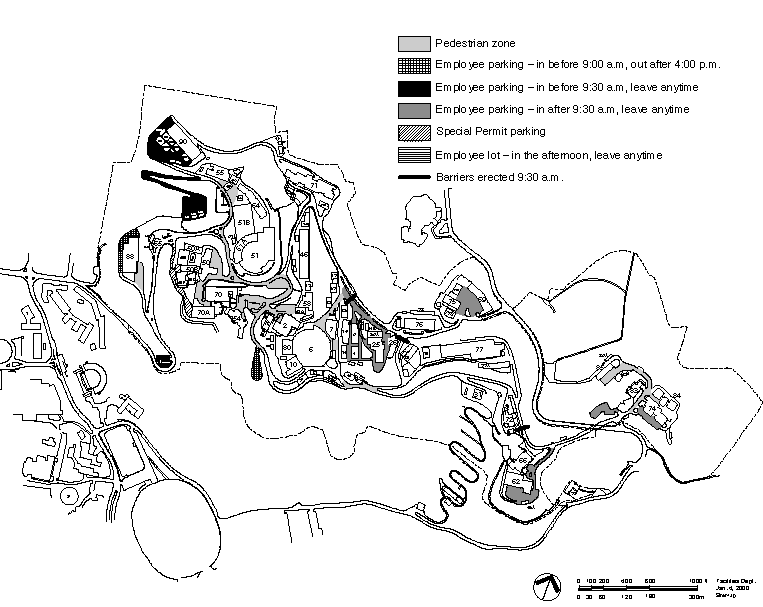 |
Washington Report
MIT Professor to Head DOE's Office of Science
President Clinton has nominated Mildred Dresselhaus, Institute Professor of Electrical Engineering and Physics at MIT, to succeed Martha Krebs as the next director of the Department of Energy's Office of Science.
A former president of the AAAS and the APS, treasurer for the NAS, and director of MIT's Center for Materials Science and Engineering, Dresselhaus is a solid state physicist who has been associated with MIT since 1960; she holds faculty appointments in both the Department of Electrical Engineering and Computer Science and the Department of Physics. In 1990 she received the National Medal of Science, the country's highest scientific award, for her research in the electronic properties of metals and semimetals and for her work in developing wider opportunities for women in science and engineering.
In recent years, Dresselhaus has focused her studies on carbon fibers and nanotubes, and high Tc superconductors. She is the author of three books on carbon science plus numerous scientific papers. Last year she received APS' Nicholson Medal for Humanitarian Service. She is a member of the National Academy of Sciences, the National Academy of Engineering, and the American Philosophical Society, and a Fellow of the American Academy of Arts and Sciences, the American Physical Society, the American Association for the Advancement of Science, IEEE, the Materials Research Society, and the Society of Women Engineers.
New DOE Oakland Operations Manager
Camille Yuan-Soo Hoo, a 23-year veteran at the DOE, was recently named the new manager of the DOE's Oakland Operations Office. She is currently the chief financial officer and business manager for the Oakland Office. Yuan-Soo Hoo is replacing James M. Turner, who will become the assistant deputy administrator for International Nuclear Safety and Cooperation in the DOE's National Nuclear Security Administration.
The Oakland Operations Office, with some 330 employees and a $2 million budget, manages federal research and development contracts for the DOE's three area facilities -- Lawrence Berkeley and Livermore National Laboratories and the Stanford Linear Accelerator Center.
Yuan-Soo Hoo began her career in 1976 at the Richland Operations Office as a budget analyst. In 1992 she was appointed to her current position as field chief financial officer. She played an influential role in the areas of budget, finance and accounting, business evaluation, information management, personnel management, contractor industrial relations, and the financial assistance center.
Lab Awarded Golf Tournament Trophy
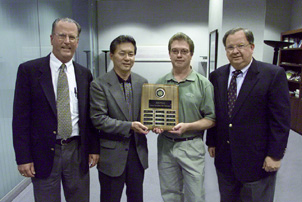 |
Guggenheim Fellowships
Two Berkeley Lab scientists are among the nine UC recipients of the prestigious Guggenheim fellowships for 2000, awarded by the New York-based John Simon Guggenheim Memorial Foundation. They are:
Donald J. DePaolo of Earth Sciences, head of Berkeley Lab's Center for Isotope Geochemistry and a professor at UC Berkeley. He is recognized for his contributions to the geochemical effects of magma generation and transport; and
Daniel S. Rokhsar of Physical Biosciences, head of the division's Computational and Theoretical Biology Department and professor of physics at UC Berkeley. His award is for his studies in computational and theoretical biology.
This year's Guggenheim honorees include 182 artists, scholars and scientists from across North America. The grants are awarded for periods ranging from six to 12 months.
Tritium at Center of School Board Controversy
Swift reaction from Lab, Media, UC, LHS
By Ron Kolb
An Alameda County School Board's controversial decision to warn parents about alleged tritium contamination at the Lawrence Hall of Science will get a rehearing next week, thanks to protests expressed by Berkeley Lab, the Hall of Science, and the University of California at Berkeley.
None of these three entities were told in advance about the resolution passed by the board on April 11, which called for advisory messages to be sent to all parents and teachers in county public schools. The message would alert them to "harmful chemicals" being released by the Lab's National Tritium Labeling Facility, and it called for a moratorium on all school visits to the Hall of Science "until LBNL is responsive to community concerns."
The response was immediate. Berkeley Lab issued a statement condemning the action, which it said was "based upon only partial and very misleading information." Citing the lack of any input from the Lab, the Hall of Science, UC Berkeley, or federal and state regulators, the statement called for a reconsideration of the action in light of the missing data.
Such a call was granted, and the Board will revisit the issue on Tuesday, April 25, at 313 Winton Avenue in Hayward, beginning at 7 p.m.
Hall of Science Director Ian Carmichael was similarly upset. "By failing to ask the university to respond to the unsupported allegations, the board has neglected what these children and their teachers understand and are seeking: the ability to access and carefully consider sound scientific data to make educated, informed decisions," he said.
And he concluded, "There is no health risk at the Lawrence Hall of Science."
The Alameda County School Board, on a 5-1 vote, apparently passed its resolution after only hearing a presentation from a group of activists led by Berkeley's Committee to Minimize Toxic Waste. It did not consider evidence from the Environmental Protection Agency, the U.S. Surgeon General, or the California Department of Health, all of whom have concluded that the Laboratory's tritium releases are minute and present no health hazard to employees or visitors.
Media reaction was swift, too. An editorial in the San Jose Mercury News on Sunday noted that "spreading fears rather than examining facts is no example to set for schools and students; making decisions without gathering information is no way to set public policy." It continued, "It is easy to spread unfounded fears on nuclear issues, which are complex and conjure up in the public's mind the horrors of weaponry and disasters. But radioactive isotopes are not merely results of atomic bombs; they're also useful tools."
And the editorial stated, "Lawrence Berkeley Laboratory does not endanger visitors, nearby residents, or even workers."
Chip Johnson, columnist for the San Francisco Chronicle, called the board's decision "weird science." And Bill Wattenburg, talk show host for KGO Radio, devoted considerable time on his Saturday and Sunday night programs to criticism of the board's action.
The Laboratory's statement concluded, "It is the Laboratory's hope that the board will reconsider its premature resolution and reverse it so that the children of Alameda County are not deprived of the unique and wonderful experience that awaits them at the Lawrence Hall of Science. The Laboratory is confident that, as the Berkeley Unified School District did in 1997, the Alameda County Board of Education will reject this resolution once it hears a balanced set of facts from all parties."
In the meantime, the Laboratory's Environmental Sampling Project Task Force will discuss a draft tritium sampling plan at its next meeting, also set for April 25 at the First Congregational Church, 2345 Channing Way in Berkeley, beginning at 6:30 p.m.
Berkeley Lab Currents
EDITOR: Monica Friedlander, (510) 495-2248, msfriedlander@lbl.gov
STAFF
WRITERS: Paul Preuss, (510) 486-6249; Lynn Yarris, (510)
486-5375
CONTRIBUTING WRITERS: Jon Bashor, X5849; Allan Chen, X4210, Jeffery
Kahn, X4019
FLEA MARKET / CALENDAR: 486-5771
fleamarket@lbl.gov /
currents_calendar@lbl.gov
Public Information Department, Berkeley Lab, MS 65A
One Cyclotron Road,
Berkeley CA 94720
Tel: 510/486-5771 Fax: 510/486-6641
Berkeley Lab is managed by the University of California for the U.S. Department of Energy.
Berkeley Lab Part of "Virtual Lab" for Fusion R&D
By Lynn Yarris
Berkeley Lab has joined forces with Lawrence Livermore National Lab (LLNL) and the Princeton Plasma Physics Lab (PPPL) in a memorandum of agreement (MOA) to create a "virtual lab" that will conduct research on heavy ion inertial fusion energy. The MOA will be funded through DOE's Office of Fusion Energy Science.
Under the terms of the MOA, participants in the new Heavy Ion Fusion Virtual National Laboratory (HIF-VNL) will collaborate on "conducting heavy ion driver development and related topics in the common pursuit of Inertial Fusion Energy (IFE), and promoting more rapid progress in the development of heavy ion drivers through technical management integration of the laboratories' scientific staff, equipment, and experimental facilities."
"This is a voluntary agreement among the laboratories that enables effective direction of the national heavy ion fusion program and increases the efficiency of that effort," says John Barnard, an LLNL fusion physicist who is responsible for the physics design effort of the Integrated Research Experiment (IRE), an HIF-VNL initiative to design and construct a particle accelerator that could address many of the critical technological issues concerning the use of heavy ion beams to drive an inertial fusion energy reactor.
Roger Bangerter of Berkeley Lab's Accelerator and Fusion Research Division (AFRD) will be the director of the HIF-VNL. The deputy directors will be Grant Logan of LLNL and Ronald Davidson of PPPL. Vic Karpenko of LLNL will be the Project Engineer and IRE Project Manager.
Other project managers will include, from Berkeley Lab, Peter Seidl, who will be responsible for the High Current Experiment, Joe Kwan, who will be responsible for Ion Sources and Injectors, and Simon Yu, who will be responsible for Final Transport and Focusing, and from LLNL, Alex Friedman, who will be responsible for Accelerator Modeling.
The HIF-VNL will have an Oversight Board appointed by the respective Laboratory Directors and a Program Advisory Committee, reporting to the Oversight Board. The Oversight Board now consists of AFRD division director William Barletta, John Lindl of LLNL and Rob Goldston of PPPL.
Stephen Dean, president of Fusion Power Associates, a fusion advocacy group, hailed the HIF-VNL agreement as proof that the non-weapons labs can still collaborate on research projects with the weapons labs even though the latter are now a part of National Nuclear Security Administration. He expressed hope the agreement will pursuade Congress to increase funding for heavy ion fusion research.
Rep. Calvert Visits Genome Institute
Last Thrusday, April 18, Congressman Ken Calvert (R-Riverside) visited DOE's Joint Genome Institute (JGI), of which Berkeley Lab is one of three institutional collaborators.
Calvert, who is the chairman of the House Science Committee's Energy and Environment Subcommittee, was accompanied by a member of his subcommittee staff, Rob Hood, and his legislative director, Chris Pedigo. Calvert was met by Director Shank, JGI Director Elbert Branscomb, and Deputy Director Trevor Hawkins.
Calvert and his staff received a briefing on the JGI, its history and accomplishments, and toured the facility. Calvert's subcommittee is responsible for authorizing the budget for DOE's scientific research programs, and recently held a hearing on the genome project.
Lab Program Gives New Meaning to Student Internships
School to Career project places interns in jobs at Lab
By Jeffery Kahn
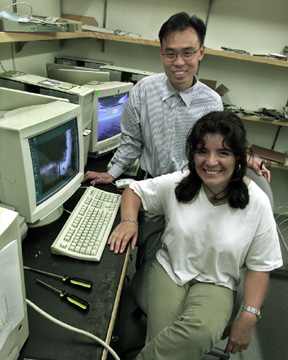 |
After graduating from high school, he studied to be an auto mechanic, gave that up, and took business classes that led to a job at a paper conversion facility. Ten year later, Huynh went back to school, intent upon a new career in computing. Although he acquired certification as a Novell netware technician, he couldn't find a job. Undeterred, he went back to school. It was at the College of Alameda in February 1999 that he learned about a program just gearing up here at the Laboratory.
The School to Career program takes the idea of a traditional internship and dramatically extends it. Students interning at jobs at the Lab receive academic credit and pay. And upon completion of the program, the student becomes a Laboratory employee.
Huynh is one of the first three School to Career program participants to be hired by the Lab. He, along with Carolina Pezua, are part of the Mac and PC Support Group, both of whom are matrixed to the Facilities Department. Bettyjane Luzietti is the third member of this initial class to be hired, working in the Facilities Department's architectural group.
The School to Career program was created as part of a broader effort to increase the diversity of the Laboratory workforce. In providing employment opportunities for qualified individuals, the program also serves as a creative recruitment tool, giving the Berkeley Lab a competitive edge in the very tight California labor market.
Harry Reed, head of the Work Force Diversity Office, said that when he and Deputy Director Klaus Berkner started the program, "We were looking for a way to develop more entry-level employment opportunities, and to make those opportunities available to groups historically under-represented in our workforce. Toward that end, we looked at occupational categories where we might build such a program, and where we would focus our outreach efforts."
Among the first areas identified as ripe for such a program were computing services, administrative services, and various positions in Facilities, including architectural and engineering design.
Reed and Berkner then sought out East Bay colleges with student bodies typical of the diversity of the state's population, looking for strong programs in these targeted occupational areas. Ultimately, they found what they were seeking at the Peralta Community College system, which includes the Laney and Merritt Colleges in Oakland, Vista College in Berkeley, and Alameda College in Alameda.
"We had to explore what the local community colleges had to offer," said Reed. "We weren't certain that they would be teaching the kind of courses that met Lab skill requirements. We expected that there would be something of a gap, but we were pleased enough with what was being taught and with the enthusiasm Peralta faculty members and students showed with the program that we were able to move forward."
Students in the School to Career program can work at the Lab up to 20 hours a week during the semester and full time during the summer. Currently, Facilities, Administrative Services, and Computing Sciences all have Peralta students employed in this work-credit program.
Although only about a year old, the program has been so successful that the Lab is exploring extending it into other job areas. Karen Ramorino, the program development specialist in the Work Force Diversity Office is assisting the Engineering Division, which is considering using the program to hire mechanical and electronic technicians.
Engineering Division Technical Services Department supervisors have invested their time, traveling to schools to speak about a career here. Additionally, the Lab has set up tours, bringing local junior college professors to the Laboratory to familiarize them with the opportunities awaiting their students
Said Ramorino, "In the case of mechanical and electronic technicians, we have lots of competition from other employers who want to hire these students. So in this case, we are considering bringing the students in not as interns but as employees at an entry level, but still under the School to Career program."
Reed said departments and divisions interested in using the School to Career program to help fill their employment needs should contact him or Ramorino. "Think of it as an innovative recruitment approach," said Reed, "and a chance to compete for employees in a very hot job marketplace."
Carolina Pezua came to the Lab through this program, becoming a full time employee in September. A native of Peru who had worked in local restaurants for the past decade, she learned about School to Career while taking computer classes at College of Alameda.
"My college computer classes were helpful," said Pezua, "but the hands-on experience working with MPSG (Mac and PC Support Group) during my internship was invaluable. It's been great for me and it looks like it's good for my department, too. Right now, we have three more interns in MPSG."
DOE Diversity Program Easily Available to All
By Ron Kolb
More than 30 U.S. Department of Energy facilities, including Berkeley Lab, received a simultaneous satellite transmission on April 5 which showcased the DOE's equal employment opportunity procedures, principles and staff.
The so-called "diversity stand-down" was directed at all DOE employees and included local programs conducted by each facility. At Berkeley Lab, Director Charles Shank reflected upon institutional and personal priorities; and Union Bank's Randy Lowe, Senior Vice President and Manager of Corporate Employment and Diversity, shared the philosophies and practices of the bank's nationally recognized diversity program.
Energy Secretary Bill Richardson scheduled the unusual "all-hands" meeting as an outgrowth of the recent report by the Department's Task Force Against Racial Profiling, which investigated employee concerns about possible racial or ethnic bias or discrimination in the wake of allegations of espionage at DOE's classified labs. He asked that all employees participate in the training, either live or on videotape.
Berkeley Lab's opportunities for live viewing were limited to the auditoriums in Buildings 50 and 66. However, at least two dozen additional showings were scheduled in both locations and will continue to be offered through Wednesday, May 3. (See below.)
All career employees are expected to view the tape and report on their participation to their division director or department head by Friday, May 5. Those who have difficulty attending one of the scheduled videotape viewings can make arrangements with their divisions or departments for alternate opportunities, such as tape loans for home viewing.
The program is also available via video streaming on the Internet through the following web site: http://lbl-web.lbl.gov. (Select the program from the list of "recorded meetings" on the site, then use initials for the username. No password is required.)
Viewing is limited to 40 connections at a time and requires Real Networks Realplayer Basic Version 7, which can be downloaded for free by following instructions at http://www-cnr.lbl.gov/vcs/.
Employees connected to the Lab network with PC's using Windows 95, Windows 98 first edition, or Windows NT can view the program at http://www-cnr.lbl.gov/vcs/ by downloading software (Cisco's IPTV) and following instructions. Showings repeat every two hours on the even hour.
Lab showings of the two-hour videotape
- Bldg. 66 auditorium: Monday at 9 a.m.,Tuesday at 8 a.m., Wed-nesday at 10 a.m., and Friday at 8 a.m.
- Bldg. 50 auditorium: Monday at 10:30 a.m., Tuesday at 8 a.m., and Wednesday at 1 p.m
- Next week, Bldg. 50 auditorium: Monday, May 1 at 10:30 a.m., May 2 at 8 a.m., and May 3 at 1 p.m.
Bulletin Board
Eco Fair 2000
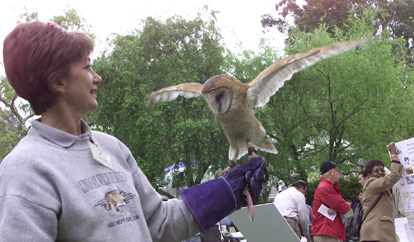 |
Skin Cancer Screening Clinic
Health Services is conducting its annual free skin cancer screening clinic on Friday, May 5, from 8 a.m. to noon. Dermatologist Elizabeth Ringrose will be onsite to screen employees for skin cancer. All Lab employees who believe they may be at risk are encourages to make an appointment by calling Health Services at X6266.
Spring Blood Drive on May 2
The next onsite blood drive -- part of an ongoing partnership between Berkeley Lab and the Blood Bank of Alameda-Contra Costa Counties -- is scheduled for Tuesday, May 2 from 7 a.m. till 1 p.m. in Bldg. 70A-3377.
Donors are encouraged to sign up online at the BeADonor website ( http://www.beadonor.com) to help organizers plan the event. Please use company code "LBL" on the web form.
To be eligible, donors must be in good health, at least 17 years old, weigh at least 110 pounds, and have not donated blood in the last 56 days.
For more information contact Denishi Blake at X4009 or DVBlake@lbl.gov, or look up the BeADonor website.
Daughters and Sons to Work Day: Update
Berkeley Lab's observance of Daughters and Sons to Work Day on April 27 has been enhanced, with a full description of the day's events available online at http://www.lbl.gov/Workplace/DSTW/.
Added to the program are assemblies in the Bldg. 66 auditorium at 9:30 a.m. and 3 p.m. Under this new format students may spend some time with their parents in their work setting, have a pizza lunch at 12:00 (which they can purchase at a booth in the cafeteria lawn area) and then attend the "Quakes and Shakes" assembly program at 1 p.m. in the Bldg. 50 auditorium. Susana Deustua will serve as facilitator and hostess for the day.
Event organizers realize that having children in the work place all day can be taxing. Parents therefore have the option of dropping off their children at the 9:30 a.m. or 3 p.m. assembly, provided they sign up their children into these sessions.
Registration is required to ensure that enough lunches are available. Forms will be placed in the cafeteria and around the Lab and can be downloaded off the DSTW web page listed above. Questions should be directed to the Center for Science and Engineering Education at X5511 or to Candie Leonard at X5816.
New Job Posting Website Launched
The Human Resources Department has launched a Current Job Opportunities website at http:// cjo.lbl.gov/. The site has been completely redesigned to enhance functionality, appearance and ease of use.
Users may search the Lab's job openings using any of four search avenues: division name, career path, keyword, or alphabetical listing of job openings.
Applicants will also be able to submit a resume online that will feed directly into HR's resume database.
HR Personal Data Sheet Mailed Out
On Monday all Lab employees should have received a document sent by the Human Resources Departments with information on current personal data stored in the Lab's payroll system. All employees are asked to review the information and return the form with any changes or corrections to Mailstop 937-600 by Friday, May 5.
LBNL Karate Club Classes
The LBNL Karate and Arnis (Pilipino Stick Fighting) Club holds classes on Tuesdays and Thursdays from 5 to 6:15 p.m. on the lower level of Bldg. 51 (the Bevatron). For more information call John Spring at X2844.
Notice of Medical Examination Settlement
The following notice to Berkeley Lab employees has been prepared as a result of the pending settlement of a class action lawsuit filed in 1995 concerning the Laboratory's medical examination program. On March 13, 2000, Federal District Judge Vaughn Walker issued an order granting preliminary approval of a settlement in this matter.
Norman-Bloodsaw, et al. v. The Regents of the University of California, et al., involves claims that the inclusion of tests for pregnancy, sickle cell trait, and syphilis -- among other laboratory tests performed as part of general medical examinations required as a condition of employment -- violated certain laws.
The District Court initially dismissed the lawsuit, but the Ninth Circuit Court of Appeals then reversed the decision, in part, and returned the case for continued litigation. The parties subsequently agreed to engage the services of a mediator to assist in reaching a settlement.
Now that the Court has given its preliminary approval to the settlement, potential members of the class have been sent notices approved by the Court. These notices describe the background of the lawsuit, the principal terms of settlement, and the steps potential members of the class may take to participate in the settlement or raise questions about it.
Please note that many current employees at the Laboratory will not be eligible to participate in the settlement because their employment began after the medical tests that were the subject of the complaint were dropped from the medical examination process. In general, no one hired after June of 1995, the month in which the last of the three tests was dropped from the program, should expect to receive a notice.
While many of the rest of the Laboratory's employees may understandably be interested in the terms of the settlement and the procedural steps to follow, employees are asked not to call Laboratory offices concerning these matters. The Court-approved notice they receive will provide such information.
In addition, anyone with questions concerning the content of the notice or who should have received one can use a toll-free number which has been established for that purpose. That number is 800-973-7554. It is also identified in the notice of settlement.
Even though there has been preliminary approval of a settlement agreement, the parties still consider themselves to be engaged in the settlement process until the Court finally approves the settlement. Such final approval can only occur after the Court holds a "fairness hearing" and approves the settlement after having heard and considered arguments and evidence presented at such a hearing. This is typically a several-month process, during which the parties will continue to adhere to their mediation agreement to refrain from public comment about the case or the issues it presents.
Calendar of Events
April 21 - May 5, 2000
THURS, APRIL 27
Daughters & Sons to Work DayStarts at 9:30 in Bldg. 66 audit.
SAT, APRIL 29
Berkeley Bay Festival & Straw Bale Building Groundbreaking11:00 a.m., Berkeley Marina (See Currents, March 24)
TUES, MAY 2
Blood Drive7:00 - 1:00, Bldg. 70A-3377
THURS, MAY 4
Shoemobile7:30 - 3:30, cafeteria parking lot
Tripmobile
11:30 - 12:40, cafeteria parking lot
FRI, MAY 5
Skin Cancer Screening Clinic8 a.m. - 12 p.m., call X6266
Showings of the DOE Diversity Program are offered a few times a week through May 3. See Page 5 for full schedule for Bldgs. 50 and 66.
Items for the calendars may be e-mailed to currents_calendar@ lbl.gov, faxed to X6641, or mailed to Bldg. 65B. The deadline for the May 5 issue is 5 p.m. Monday, May 1.
Seminars & Lectures
TUES, APRIL 25
Life Sciences Division"From Small to Large-Scale Protein Interaction Maps to Function" will be presented by Russell Finley, Jr. of Wayne State University.
4:00 p.m., Bldg. 84-318
Refreshments precede seminar.
WED, APRIL 26
Nuclear Science Department Colloquium"Neutron Science at the Spallation Neutron Source (SNS)" will be presented by Thom Mason of Oak Ridge National Lab.
11:00 am, Bldg. 50 auditorium
TUES, MAY 2
Life Sciences Division and Graduate Group"Structural Studies of a Gated Mechanosensitive Ion Channel" will be presented by Douglas C. Rees of the Howard Hughes Medical Institute.
4:00 p.m., Bldg. 84-318
Refreshments precede the seminar.
TUES, MAY 2
Physics Division Research Project Meeting"Voodoo Science" will be presented by Robert Park of the University of Maryland/APS.
4:00 p.m. Bldg 50A-5132
Refreshments at 3:40
THURS, MAY 4
Physics Division Research Progress Meeting"NASA's Cosmic Journeys Program: To the Edge of Gravity, Space, and Time" will be presented by Nicholas White of NASA/Goddard.
4:00 p.m. Bldg. 50A-5132
Refreshments at 3:40 p.m.
FRI, MAY 12
Center For Beam Physics Seminar Series"Ponderomotive Laser Acceleration and Focusing in Vacuum: Application for Attosecond Electron Bunches" will be presented by Gennady Stupakov of SLAC.
10:30 a.m., Bldg. 71 conf. rm.
Refreshments at 10:20 a.m.
EH&S Classes - May 2000
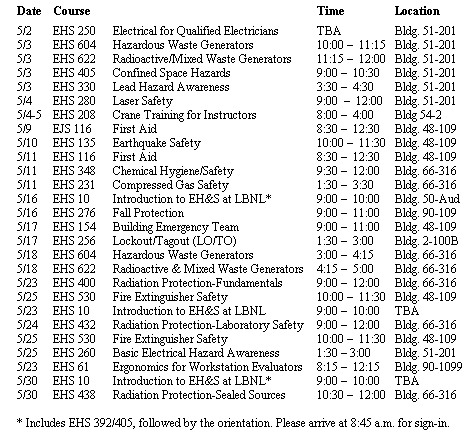
EH&S Update
New Lead Hazard Course
The EH&S Division has developed a new Lead HazCom Training Course (EHS 329) which is now available on the EH&S website.
The course is intended for employees who may be exposed to small amounts of lead in their jobs. (Tasks that may result in such lead exposure include manipulating lead bricks, soldering with lead/tin solder, or dusting around pipes/ventilation systems or other previously undisturbed areas.)
The course does not replace Lead Awareness Hazards (EHS 330), which is required for employees who may be exposed to higher levels of lead.
Questions may be directed to Carole Fried at X2603. Information about the Lead HazCom course can be found on the web at http://www.lbl.gov/ehs/lead/lead.htm.
Currents Online
The full text and photographs of each edition of Currents are published online at http://www. lbl.gov/Publications/Currents/. (Or look for a link to Currents on the Lab's home page under the heading "Publications.")
The Currents website allows users to do searches of past articles going back to 1994.
Flea Market
Autos / Supplies
`98 TOYOTA Tacoma truck, extra cab, 2.4L, 4 cyl, SR5 5 sp, man, 20K, red, cloth bucket seats, carpet, 4 spkr stereo, ac, cruise, adj steering, anti-theft, rear window, great cond, $15,300, Bob, X6227, (925) 825-1478`97 HONDA Accord EX,18K, dark green, leather int, sun roof, cd, pwr win/door, cruise, exc cond, $15,000/bo, (415) 753-2899
`91 HONDA Accord LX, 4 dr, blk, at, ac, pwr steer/win, stereo, loaded, GTE car phone, exc cond, very clean, 145K, $6,800/bo, Mohammed, pager 389-7694, 839-7204
`87 MERCURY Sable LS, 4-dr luxury sedan, exc cond, 6 cyl, auto, ac, pwr steer/win/locks, cruise, am/fm/cass, beige, 1 owner, $3,500, neg, Tennessee, 523-4838
`85 VW GOLF GTI, manual, new brakes/radiator, engine in gd cond, 128K, sunrf, $1,500, Alexander, X5946, 665-5920
`84 TOYOTA Camry hatchback, auto, ac, pwr seat/win, cruise, am/fm/cass, gd cond, runs great, gd mpg, 105K, $2,250/bo, 339-0136, (925) 376-5171
`77 CHEVY van, runs fine, great for hauling, 165K, $1,100, Bob, X4451, 548-2429
Housing Available
BERKELEY, 2 bdrm apt, very close to Ashby BART, friendly neighbors, 1 or 2 rooms avail anytime to sublet until Nov, $900 whole place or $450 + bills for 1 med sized rm, Eva or Lark, 985-6499N. BERKELEY, fully furn studio, drapes, linen, phone line, partial view, carpet, kitchen, laundry, avail 4/17, 5/1 ok, non-smok, no pets, $800+PGE, move in $1,300, Rachel, 548-0431
ELMWOOD, woman sought to share elegant 11-rm house w/ 2 men, 1 woman, non-smok prof, mastr bedrm w/ frplc, huge closet, piano, yellow Laborador, laundry, sauna, hardwd flrs, shared dinners, exc loc, $695-750/mo + dep, shared exp, Tony, 841-4480
N. OAKLAND, room in 3 bdrm house, $600/mo, avail May and June, quiet street, hardwd flrs, laundry, no pets/smoking, X2420
PLEASANT HILL, Walnut Creek/ Lafayette border, modern, nicely furn home, 3 bdrms, formal dining rm, lge fam rm, lge deck, all amen, exc loc, near transp/BART, mid-May to late June, 4-6 weeks, rent/time nego, non-smok, Natalie, (925) 934-0759, Werner, (925) 937-6433
ROCKRIDGE, unfurn room for rent in furn 2 bdrm/1bth dup, shared kitchen, dining rm, living rm, basement w/ wash/dry, yard, hardwd flrs, no pets, no smok, str parking, near BART, shuttle, College Ave shops & more, $550/mo, Maria, X6184
Housing Wanted
BERKELEY, room/apt near lab/campus for 1 or 2 female summer students, June to mid-Aug, Fred, X4892BERKELEY, summer sublet/housing for visiting scholar from India, 6/10 to 7/30, near shuttle route or campus, quiet, responsible, non-smoker, Alyssa, X5958, 985-1818
VISITING EPIDEMIOLOGIST seeks 2 to 3 bdrm/2 bth house in Albany/Kensington/Berk/Oak, 1 to 2 years begin in May, non-smoker, no pets, quiet, flex on start date/rent, X5910 or X6591
VISITING SCIENTIST w/ wife, daughter seeks 2 bdrm house/apt, start 7/16 for approx 2.5 mos, prefer loc close to lab shuttle, Rick, X4258
Miscellaneous
CLOSET CABINET/BOOKCASE tall/narrow, lots of adj shelves, 72"x12"x12", new, assembled, white, bo, 601-5757COLOR PRINTER Hewlett Pack-ard Desk Jet 600C, works great, needs black ink cartridge, $50; pool table, 8' x4'3x2'6, gd cond, $300, Karen, X5750, 724-8138
CRIB, exc cond, wood, dark finish; Sealy mattress, $50, Jeff, X5153
CRIB, white metal, exc shape, $25, Francesca, X7193
CURTAINS, Roman style fabric shades in southwest pattern, 2 are 57" high x 65" wide, $15 ea; 2 are 57" high by 32" wide $10 ea; 1 is 80" high x 100" wide, $20, or $50 for all; exercise bicycle, AIRgometer model, gd cond, LED display shows spd, dist, rpm, heart rate, calories, $50, Marion, X2915, 527-2524
FILE CABINET, oak, 4 drwr, $25, Rosemary, X2426, (925) 229-4275
FILE CABINETS, lateral, 36"x18"x65", 5 tiers, have 3 units, $40/bo each; storage space to share, 1/2 of small garage, $37/mo; bike trailer, Rhode Gear, for 1 or 2 kids, little use, $150/bo, Jonathan, X4148
GATEWAY PC, 150mhz Pentium O/D, 32MB, 3GB, 56K modem, 15" monitor, $275; new IBM 15" monitor, $100, Lynn, (925) 691-6081
HUGE ESTATE SALE, antiques, furn, dishes, kitchenware, etc, everything priced to sell, 439 Oakland Ave #1, 9:30 to 4, 4/29 & 4/30, 465-4486
MAC COMPUTER, Performa 475, $100; Zip drive, $25; HP printer, Deskwriter 540, $50; 56K modem, $25 with manuals, all or part, B Gordon, 233-7244
MATTRESS, twin size, w/ box springs, 2 yrs old, very clean, $60, Chris, X6901
MOVING SALE, Panasonic 28" TV, $150; futon bed, blk metal frame, $75; twin bed, $100; other items, Edwin, 848 7549, X4816
MISC SALE: 15" Sony Trinitron TV, $25; kneeling chair, ex cond, $20; 1 intro Russian language tape/book, $10; 2 intro German language tapes/book, new, $15; Garrett, X2324
Wanted
COED SOCCER team needs experienced female players, games are Sun morns, also need a goalie, H Matis, X5031, 540-6718EXCHANGE CAT SITTING, I'll look after your cat on vac, you return the favor, Berkeley, 1 low-maint kitty, Melissa, 665-5572
HOUSESITTER, nice house, walking dist from Lab, walk/feed dog in return for free lodging, 4/28 to 5/15, Fred, X4892
REFRIGERATOR/WASHER/DRYER, used, need by early May, Marlene, X2770
VAN POOL from SF, Haight/Noe Valley/Castro regions to UCB/ LBNL, 8 am/5 pm, need extra riders, David, X6013
Lost & Found
LOST: Left in Bldg 50 women's bathroom on main floor, March 28, small brown box with gold earrings and necklace with pendant of the Parthenon, Brionna, X7689FOUND: 4 lithium ion batteries for Sanyo camcorder, X7402
Note: For other lost and found items call X4855
Free
FIREWOOD, mixed pine/hardwood, cord, David, X4127, 525-4470
Flea Market Policy
Submissions must include name, affiliation, extension, and home phone number.
Ads must be submitted in writing only -- via e-mail (fleamarket@lbl.gov), fax (X6641), or delivered/ mailed to Bldg. 65B. Ads run one week only unless resubmitted in writing, and are repeated only as space permits.
Currents reserves the right to edit ads for space and style.
The deadline for the May 5 issue is Thursday, April 27.
